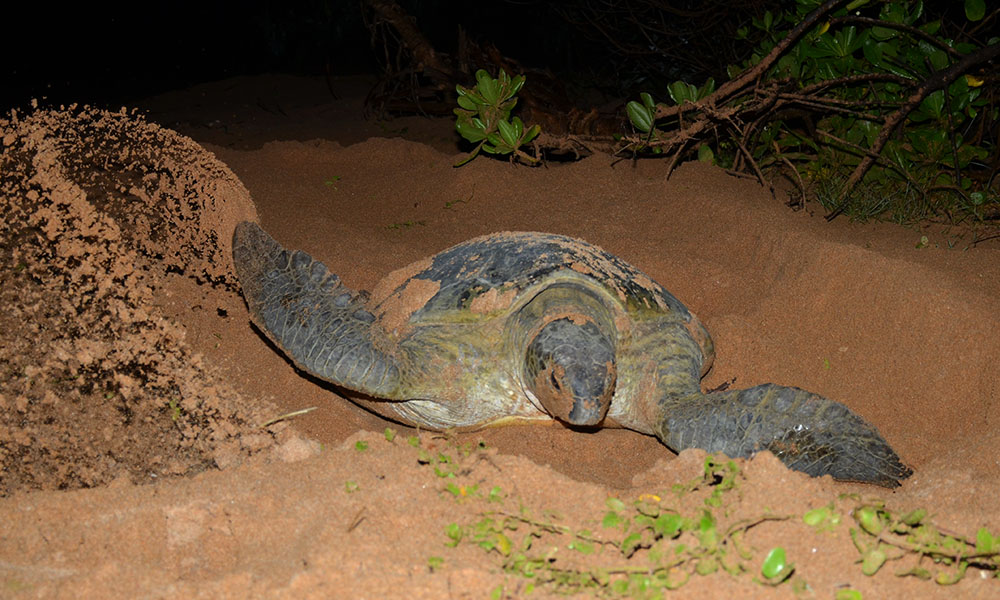Turtle nesting is a fascinating natural phenomenon where female sea turtles come ashore to lay their eggs on sandy beaches. This process is critical for the survival of turtle populations and occurs in various parts of the world, including Sri Lanka, which is known for its significant turtle nesting sites. Here’s an overview of turtle nesting, its importance, and how to responsibly observe this incredible event.
Overview of Turtle Nesting
- Nesting Season:
- Turtle nesting generally occurs from late spring to early fall, although specific timings can vary based on the species and geographic location.
- In Sri Lanka, the peak nesting season for species like the Olive Ridley and Green Turtle typically runs from May to October.
- Nesting Process:
- Female turtles usually return to the same beach where they were born to lay their eggs. This behavior is known as natal homing.
- After emerging from the ocean, the female digs a nest in the sand using her flippers, lays around 100 to 200 eggs, and then covers the nest before returning to the sea.
- The incubation period for turtle eggs is about 50 to 70 days, depending on the species and environmental conditions.
- Species of Sea Turtles:
- Several species of sea turtles nest on Sri Lankan beaches, including:
- Olive Ridley Turtle (Lepidochelys olivacea)
- Green Turtle (Chelonia mydas)
- Hawksbill Turtle (Eretmochelys imbricata)
- Loggerhead Turtle (Caretta caretta)
- Leatherback Turtle (Dermochelys coriacea) (less common)
- Several species of sea turtles nest on Sri Lankan beaches, including:
Importance of Turtle Nesting
- Biodiversity:
- Sea turtles play a vital role in marine ecosystems, contributing to the health of seagrass beds and coral reefs.
- They are considered keystone species, meaning their presence helps maintain the structure of the ecological community.
- Conservation:
- Many turtle species are threatened or endangered due to habitat loss, pollution, climate change, and poaching.
- Protecting nesting sites and hatcheries is crucial for the survival of these species and the biodiversity of marine ecosystems.
- Tourism and Education:
- Turtle nesting sites are popular tourist attractions, offering opportunities for eco-tourism and raising awareness about conservation.
- Responsible ecotourism can provide financial support for local communities and conservation efforts.
Responsible Turtle Nesting Observation
- Respect Wildlife:
- Always maintain a safe distance from nesting turtles and their nests.
- Avoid using bright lights or flash photography, as it can disturb the turtles and disorient hatchlings.
- Follow Local Guidelines:
- Join guided tours organized by reputable organizations that follow ethical practices for observing turtle nesting.
- Follow local laws and regulations regarding turtle conservation and nesting site protection.
- Participate in Conservation Efforts:
- Engage with local conservation projects or organizations that focus on protecting nesting sites and rehabilitating injured turtles.
- Volunteer opportunities often exist at turtle hatcheries where individuals can help monitor nests and educate the public.
- Educate Others:
- Share your knowledge about turtle nesting and the importance of conservation with friends, family, and your community.
- Advocate for responsible tourism practices that protect turtle nesting sites and marine habitats.
Conclusion
Turtle nesting is a remarkable natural event that highlights the beauty and vulnerability of marine life. By understanding and respecting this process, we can contribute to the conservation of sea turtles and their habitats while enjoying the wonders of nature. If you’re in a region known for turtle nesting, take the opportunity to witness this incredible spectacle responsibly!


Comments are closed